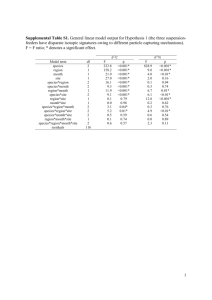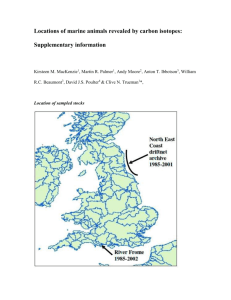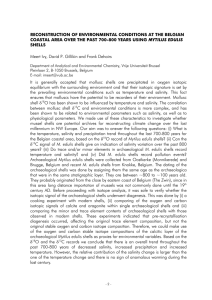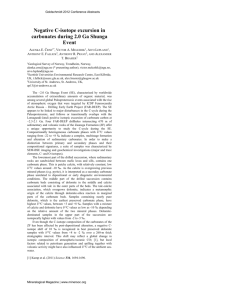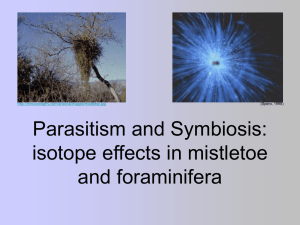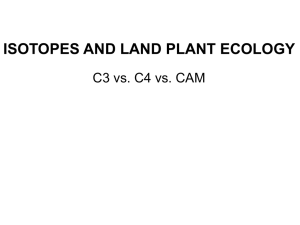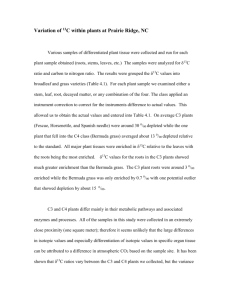Geochemistry of Marine Bivalve Shells: the potential for paleoenvironmental reconstruction
advertisement
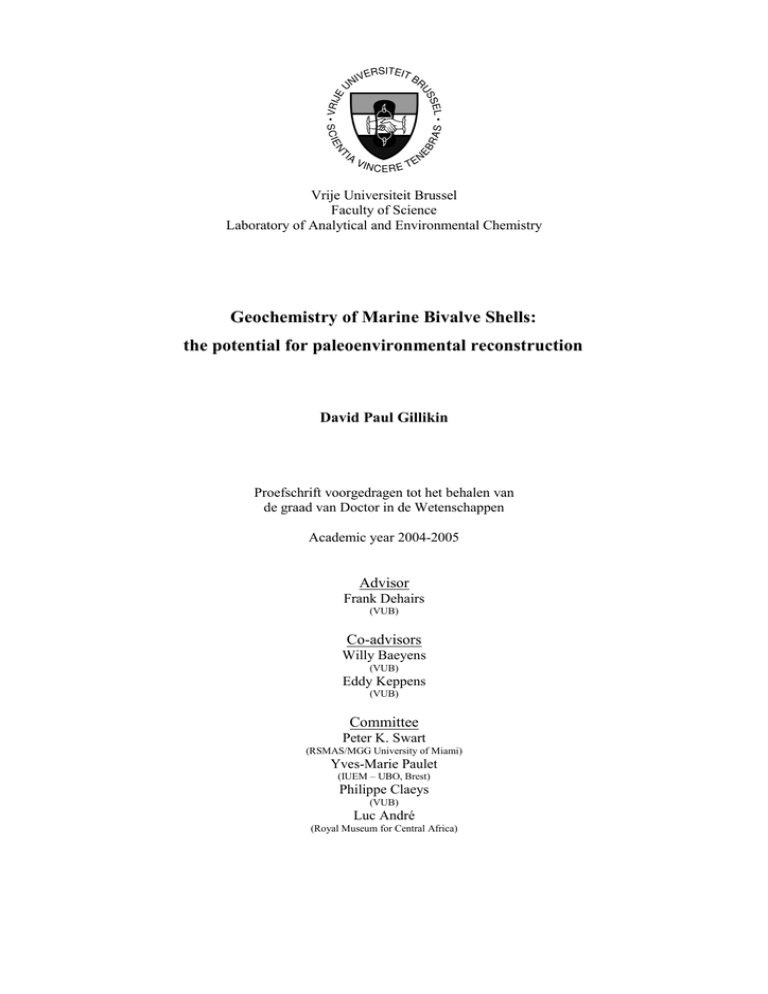
Vrije Universiteit Brussel Faculty of Science Laboratory of Analytical and Environmental Chemistry Geochemistry of Marine Bivalve Shells: the potential for paleoenvironmental reconstruction David Paul Gillikin Proefschrift voorgedragen tot het behalen van de graad van Doctor in de Wetenschappen Academic year 2004-2005 Advisor Frank Dehairs (VUB) Co-advisors Willy Baeyens (VUB) Eddy Keppens (VUB) Committee Peter K. Swart (RSMAS/MGG University of Miami) Yves-Marie Paulet (IUEM – UBO, Brest) Philippe Claeys (VUB) Luc André (Royal Museum for Central Africa) Chapter 6 The link between salinity, phytoplankton, and δ13C in Mytilus edulis Foreword In the previous Chapter, it was demonstrated that the amount of metabolic carbon incorporation into aragonite shells of Mercenaria mercenaria changed dramatically through the life of the animal. This chapter focuses on a calcitic bivalve with a much shorter lifespan. With no strong age trend, it is possible that large changes in δ13CDIC, common along many estuaries, would be recorded in the shells and potentially be useful as a salinity indicator. Chapter 6 is now in print: Gillikin, D. P., A. Lorrain, S. Bouillon, P. Willenz and F. Dehairs, 2006. Stable carbon isotopic composition of Mytilus edulis shells: relation to metabolism, salinity, •13CDIC and phytoplankton. Organic Geochemistry 37: 1371-1382. 107 Chapter 6 Abstract The incorporation of respired 13 C depleted carbon into the skeletons of aquatic invertebrates is well documented. The fluid from which these animals calcify is a ‘pool’ of metabolic CO2 and external dissolved inorganic carbon (DIC). Typically, less than 10 % of the carbon in the skeleton is metabolic in origin, although higher amounts have been reported. If this small offset is more or less constant, large biogeochemical gradients in estuaries may be recorded in the δ13C value of bivalve shells. In this study, it is assessed if the δ13C values of Mytilus edulis shells can be used as a proxy of δ13CDIC and provide an indication of salinity. First the δ13C values of respired CO2 (δ13CR) was considered using the δ13C values of tissues as a proxy for δ13CR. Along the strong biogeochemical gradient of the Scheldt estuary, δ13CR was linearly related to δ13CDIC (R2 = 0.87), which in turn was linearly related to salinity (R2 = 0.94). The mussels were highly selective, assimilating most of their carbon from phytoplankton out of the total particulate organic carbon (POC) pool. However, on a seasonal basis, tissue δ13C varies differently than δ13CDIC and δ13CPOC, most likely due to lipid content of the tissue. All shells contained less than 10 % metabolic C, but ranged from near zero to 10 %, thus excluding the use of δ13C in these shells as a robust δ13CDIC or salinity proxy. As an example, an error in salinity of about 5 would have been made at one site. Nevertheless, large changes in δ13CDIC (>2 ‰) can be determined using M. edulis shell δ13C. Preliminary hemolymph δ13C data are presented and suggest that salinity affects the δ13C of the internal DIC pool of bivalves independently from the external δ13CDIC. 108 δ13C in Mytilus edulis shells 1. INTRODUCTION The incorporation of respired 13 C depleted carbon into the skeletons of aquatic invertebrates is well documented (Tanaka et al., 1986; McConnaughey et al., 1997; Lorrain et al., 2004a; Swart et al., 2005). The fluid from which these animals calcify is a ‘pool’ of metabolic CO2 and external dissolved inorganic carbon (DIC), which both affect the skeletal stable carbon isotopic signature (δ13CS). The amount of respired carbon ending up in the skeleton is species specific, with most aquatic animals incorporating less than 10 % (or < 2 ‰ offset from δ13CS equilibrium with δ13CDIC in marine settings) (McConnaughey et al., 1997; Kennedy et al., 2001; Lorrain et al., 2004a; Chapter 4), but may be as high as 35 % (Chapter 5). Therefore it is of interest to have a better understanding of what controls the δ13C value of respired CO2. The δ13C value of respired CO2 (δ13CR) can be roughly estimated from the tissue δ13C value. At the pH of M. edulis body fluids (7 – 8; Crenshaw, 1972), more than 90 % of CO2 hydrates and ionizes to produce HCO3-, which should be at most 1 ‰ enriched in 13 C compared to the respiring tissue (McConnaughey et al., 1997). Yet, due to other processes affecting the δ13CR (e.g., the type of material being respired such as lipids) it can roughly be considered to be 0.5 ‰ heavier than the tissues (McConnaughey et al., 1997). However, a recent study on a zooxanthellate scleractinian coral suggested that δ13CR might not always follow tissue δ13C (Swart et al., 2005). The amount of respired CO2 in the skeleton can be approximated using the equation of McConnaughey et al. (1997) (see also previous chapter): M(δ13CR) + (1 – M) * δ13CDIC = δ13CS – εcl-b (1) where M is the percent metabolic CO2 contribution and εcl-b is the enrichment factor between calcite and bicarbonate (1.0 ± 0.2 ‰ in Romanek et al., 1992). Other factors may also play a role in determining the δ13C value of the internal DIC pool. For example, the enzyme carbonic anhydrase, which catalyses the reaction of bicarbonate to CO2, which can more easily diffuse through membranes (Paneth and O’Leary, 1985), may add or remove carbon species from this pool (see 3.2.2.1 of Chapter 1). 109 Chapter 6 Considering that many bivalves incorporate only a small amount of respired CO2, their skeletons should be able to trace large changes in δ13CDIC, as was found by Mook and Vogel (1968) and Mook (1971) for M. edulis in the Schelde estuary. This is also true if the offset is constant as was found in a freshwater mussel (Kaandorp et al., 2003). Such data could then be useful for roughly determining the salinity where the animals grew, which could be a valuable addition to the interpretation of shell δ18O profiles (see Chapter 4). Therefore, the δ13C values of M. edulis shells and mantle tissues, DIC, and particulate organic carbon (POC) were measured across a salinity gradient and over one year. Additionally, a preliminary experiment on the δ13C of hemolymph was conducted in the laboratory at different δ13CDIC values and a different salinity. 2. MATERIALS AND METHODS 2.1 Field data collection Mussels were collected from the intertidal zone of the Schelde estuary from Knokke (KN) and Hooftplaat (HF) on 17 March 2002 and from Griete (GR) and Ossenisse (OS) on 23 March 2002 (Fig. 1). In addition, mussels were also sampled from HF on 3 May, 28 July, and 29 September and from KN on 3 May and 28 July 2002. Mantle tissues were collected using a scalpel and stored frozen until preparation. During preparation, tissues were dried in an oven at 60 ºC for 24 hours, homogenized with a mortar and pestle, and ~1 mg material was placed into a silver cup. 2 - 3 drops of 5 % HCl was added and the cups were allowed to dry in an oven overnight after which they were folded closed. Tissue δ13C was measured on an Element Analyzer (Flash 1112 Series EA ThermoFinnigan) coupled via a CONFLO III to an IRMS (DeltaplusXL, ThermoFinnigan). Using this same instrument and method, Verheyden et al. (2004) report a long term analytical precision for δ13C of 0.08 ‰ on 214 analyses of the IAEA-CH-6 standard (1σ). Shells were sectioned along the axis of major growth and samples were drilled from the calcite layer along the growth-time axis. Carbonate powders were reacted in a Kiel III coupled to a ThermoFinnigan DeltaplusXL dual inlet IRMS with a long-term δ13CS precision of 0.039 ‰ (see Chapter 2 for more details). 110 δ13C in Mytilus edulis shells North Sea U.K. Netherlands Belgium France North Sea Oosterschelde North Sea WD Westerschelde KN HF GR The Netherlands OS Antwerp Belgium Figure 1. Map of the Westerschelde estuary. The four study sites are indicated Knokke (KN), Hooftplaat (HF), Griete (GR) and Ossenisse (OS). Scale bar = 10 km. Near-shore water samples were collected at least monthly from Nov. 2001 to Oct. 2002 for chlorophyll a concentrations (Chl a), δ13CDIC, δ13CPOC and suspended particulate matter (SPM). Chlorophyll a was measured using standard protocols (see Chapter 2). The δ13CDIC was determined by acidifying 5 ml of water in an 8 ml helium flushed headspace vial, overnight equilibration, and subsequently injecting 400 µl of the headspace into the carrier gas stream of the continuous flow IRMS. Precision of δ13CDIC was better than 0.2 ‰ based on replicate measurements; data were corrected using calibrated CO2 gas according to Miyajima et al. (1995) (see Chapter 2). The δ13CPOC was measured following Lorrain et al. (2003) (see Chapter 2 for more details) and SPM is based on the dry weights of these filters. 2.2 Laboratory experiment Mussels were held in four tanks for more than one month and were fed yeast. Three tanks had the same salinity (35) and varying δ13CDIC values, while one tank had a salinity of 19. The δ13CDIC of the water in the tanks was measured as described above. Two to five mussels per tank were sampled. Hemolymph samples were drawn from the adductor muscle of the mussels with a sterile needle and syringe, injected into He 111 Chapter 6 flushed 2 ml headspace vials, and were analyzed similar to water δ13CDIC, except 1000 µl was injected into the IRMS. 3. RESULTS The δ13CDIC was strongly related to salinity with the linear relationship: δ13CDIC = Salinity * 0.39 (± 0.03) – 13.71 (± 0.57) (R2 = 0.94, p < 0.0001, n = 63; for the salinity range of ~ 5 to 30) (Fig. 2). To approximate the δ13C value of phytoplankton, 20 ‰ was subtracted from the δ13CDIC values (see discussion). There were strong linear relationships between mantle tissue and both δ13CPOC and δ13CDIC - 20 ‰ (δ13CDIC–20; Fig. 3) for samples collected in March. The slope between mantle tissue and δ13CDIC–20 was not significantly different from one (p < 0.0001). Mantle tissue varied considerably throughout the year at HF and KN with a 2 to 3 ‰ decrease between March and September (Fig. 4). In both sites, mantle tissue was least negative in March, just before the phytoplankton bloom, but was more similar to the δ13C of potential food sources in May, July and September. 0 -2 13 δ CDIC (‰) -4 -6 -8 -10 -12 -14 2 7 12 17 22 27 32 Salinity Figure 2. δ13CDIC versus salinity from samples taken over one year along the Schelde estuary with the relationship: δ13CDIC = Salinity * 0.39 (± 0.03) – 13.71 (± 0.57) (R2 = 0.94, p < 0.0001, n = 63; for the salinity range of ~ 5 to 30). Using the εcl-b from Romanek et al. (1992), shells from KN were on average not in equilibrium with δ13CDIC, but the three other sites were (Fig. 5). Although the regression using the mean of all four sites is significant (p = 0.039, R2 = 0.94), 112 δ13C in Mytilus edulis shells removing KN results in a regression line which perfectly bisects the three means (Fig. 5). The intercept of this latter model is 1.65 (± 0.001), which is close to the expected equilibrium value with δ13CDIC = 0 ‰ (i.e., +1.0 ± 0.2 ‰, Romanek et al., 1992). High-resolution δ13CS profiles can be found in Figure 7 of Chapter 10, and show that in general, δ13CS is more negative in spring. -17.0 DIC -20 POC -19.0 Tissue δ13C (‰) -21.0 -23.0 -25.0 -27.0 -29.0 -32 -30 -28 -26 13 -24 -22 -20 13 δ CPOC and δ CDIC-20 (‰) Figure 3. Linear regressions between mantle tissue δ13C and both δ13CPOC and δ13CDIC – 20 ‰ from mussels collected in March 2002. N = 27 for all. The relationships are: Tissue δ13C = 0.99 (± 0.16) * δ13CDIC-20 + 4.89 (± 4.48) (R2 = 0.87, n = 27, p > 0.0001), and Tissue δ13C = 1.97 (± 0.31) * δ13CPOC + 25.39 (± 7.87) (R2 = 0.87, n = 27, p > 0.0001). Hemolymph δ13C values were linear with δ13CDIC between the three tanks with a salinity of 35, while hemolymph δ13C values were more negative in the lower salinity tank despite δ13CDIC being in the same range (Fig. 6). However, these data should be regarded with caution. Although preliminary attempts to determine if there was an effect of using small headspace vials (2 ml; usually, 8 – 20 ml vials are used) suggested that there was no effect, later attempts could not reproduce this. No satisfactory explanation could be found for this. Nevertheless, the fact that there was no effect of vial size during the period that these samples were measured, and the reproducibility between mussels from the same tank, indicates that the more negative hemolymph δ13C values in the lower salinity tank is probably not an artifact of measurement. 113 Chapter 6 13 δ C -19 DIC -20 POC tissue Chl a A 40 35 -20 30 -21 25 -22 20 -23 15 -24 10 -25 5 -26 Sep-01 Nov-01 Dec-01 Feb-02 Apr-02 May-02 Jul-02 Sep-02 Oct-02 Chl a (µg/l) -18 0 Dec-02 25 -18 B -19 20 15 13 δ C -21 -22 10 -23 5 -24 -25 Sep-01 Nov-01 Dec-01 Feb-02 Apr-02 May-02 Jul-02 Sep-02 Oct-02 0 Dec-02 Figure 4. Seasonal samples of mantle tissue δ13C, δ13CPOC, δ13CDIC–20, and chlorophyll a taken from Hooftplaat (A) and Knokke (B). Error bars represent standard deviations. 114 Chl a (µg/l) -20 δ13C in Mytilus edulis shells 0 KN shells equilibrium shells measured -1 -2 HF 13 δδ13C (‰) C Sshells -3 -4 GR -5 -6 OS -7 -8 -9 -10 -12 -10 -8 13 -6 -4 -2 0 13DIC (‰) δ δC C DIC Figure 5. Mean δ13Cs and δ13CDIC averaged over the full year for the four sites (noted above data points, see Fig. 1 for description of site codes). High-resolution profiles can be found in Figure 7 of Chapter 10. Also plotted are the expected shell values based on the fractionation factor between δ13CDIC and calcite (+1.0 ‰; Romanek et al., 1992). Error bars represent standard deviations. -4 tank 1 S19 tank 2 S35 tank 3 S35 tank 4 S35 13 δ C Hemolymph δ 13Chemolymph (‰) -6 y = 0.68x - 5.57 2 R = 0.73 -8 -10 -12 -14 -16 -8 -7 -6 -5 -4 -3 -2 13 δ δ CCDIC (‰) DIC 13 13 Figure 6. Hemolymph δ C from laboratory held mussels. Mussels were held in four tanks, three with a salinity of 35 (Tanks 2, 3 and 4) and one with a salinity of 19 (Tank 1). 115 -1 Chapter 6 4. DISCUSSION Although it is well established that the carbon isotope fractionation between phytoplankton and DIC is variable (Rau et al., 1992; Hinga et al., 1994; Boschker et al., 2005), a value between 18 and 22 ‰ is often used as an estimate (Cai et al., 1988; Hellings et al., 1999; Fry, 2002; Bouillon et al., 2004b). Therefore, similar to Fry (2002), the average value of 20 ‰ is used. From Fig. 3 it is clear that M. edulis is highly selective as the slope between the expected δ13C of phytoplankton and tissues is not significantly different from one, whereas the slope between δ13C of tissues and δ13CPOC was 2.0 (±0.3). δ13CPOC and δ13CDIC were also significantly correlated (δ13CPOC = 0.42 (± 0.09) * δ13CDIC – 21.0 (± 0.5); R2 = 0.61, n = 59, p < 0.0001). The POC is a mixture of different sources of carbon, each with their own δ13C values, such as phytoplankton, terrestrial carbon (in general, ~ -26 ‰ from C3 plants and ~ -14 ‰ from C4 plants; Mook and Tan, 1991), resuspended sediments (Schelde: ~ -19 to -24 ‰; Middelburg and Nieuwenhuize, 1998; Herman et al., 2000), marine macro-algae detritus (Schelde: green algae ~ -17 ‰, brown algae ~ -25 ‰; Gillikin unpublished data), microphytobenthos (Schelde: ~ -15 ‰; Middelburg et al., 2000; Herman et al., 2000), and other substances from which the mussels must select from. As these samples were taken near the shore, there was probably a large amount of suspended sediments, which is indicated by the high SPM content (range = 13 to 550 mg/l, mean = 86 mg/l). Selection can occur both at the gills (pre-ingestive) and in the gut (postingestive) (reviewed in Ward and Shumway, 2004), but using δ13C as a tracer deals only with assimilated carbon. Moreover, using the selectivity equation from Bouillon et al. (2004b), Selectivity = (∆δ13Ctissue – ∆δ13CPOC / ∆δ13CDIC – ∆δ13CPOC) *100 [%] (2) where ∆ is the overall estuarine gradient in tissue, POC and DIC δ13C values (assumes that selectivity is similar at all stations, see Bouillon et al., 2004b), suggests that they are ~90 % selective, which further illustrates that they primarily assimilate their carbon from phytoplankton, which in turn obtains its carbon from the DIC. It is generally accepted that the δ13C value of an organism reflects the δ13C value of its diet with little (1 ‰) or no change (DeNiro and Epstein, 1978; Fry and Sherr, 1984). 116 δ13C in Mytilus edulis shells Therefore, the intercept between tissue δ13C and δ13CDIC-20 should be +1. However, it should be kept in mind that the 20 ‰ fractionation used here is a rough estimate. The intercept of 4.89 ± 4.48 ‰ in Fig. 3 can therefore be explained by an error in the phytoplankton fractionation as well as the individual variation in tissue δ13C. Moreover, errors in this simplified model can arise from the mussels feeding on other food items. Mussels have been shown to feed on dissolved organic carbon (DOC) (Roditi et al., 2000), their own and other bivalve larvae (Lehane and Davenport, 2004), zooplankton (Lehane and Davenport, 2002; Wong et al., 2003), and macroalgae detritus (Levinton et al., 2002); all with different δ13C values (see above). Nevertheless, as a first approximation, δ13CR values should roughly follow DIC, as has been noticed in other bivalves (e.g., Fry, 2002). However, Swart et al. (2005) found that δ13CR from a coral significantly deviated from the δ13C of tissues (both positive and negative deviations of up to 3 ‰), which they attributed to different compounds (e.g., lipids) being respired at different times of the year. -22 DIC-20 POC -23 13 δ C tissue (‰) -24 -25 -26 δ13C tissue = 0.30 * δ13CPOC - 17.16 -27 2 R = 0.12 -28 13 13 δ C tissue = 0.34 * δ CDIC-20 - 16.20 2 R = 0.50 -29 -30 -30 -29 -28 -27 -26 -25 -24 -23 -22 13 δ C POC and DIC-20 (‰) Figure 7. Ribbed mussel (Geukensia demissa) bulk tissue δ13C versus both δ13CPOC and δ13CDIC–20 from mussels collected in August 2004 from along a salinity gradient in a North Carolina salt marsh (N = 24). Data from Gillikin and Bouillon (unpublished). Although it might seem obvious that the δ13C of filter feeders that eat phytoplankton, which in turn assimilate their carbon from DIC, would all be related to the δ13CDIC, as is the case with many bivalves (e.g., Fry, 2002), the relationship does not always hold true. For example, despite the linear relationship between salinity and δ13CDIC in a 117 Chapter 6 North Carolina salt marsh creek (δ13CDIC = 0.44 * Salinity – 14.45, R2 = 0.97, n = 15, for the salinity range of 1 – 29; Gillikin and Bouillon, unpublished data), tissues collected from the ribbed mussel, Geukensia demissa, did not follow either δ13CPOC or δ13CDIC–20 (Fig. 7). Consequently, no correlation between shell δ13C and δ13CDIC was noticed in these specimens (data not shown). Figure 8. Water temperature recorded hourly using Onset TidBit dataloggers at all four sites. The weekly running average is shown. The loggers failed at two sites for about a month as is indicated on the graph. From Fig. 4 it is evident that the relationship found in March (Fig. 3) does not necessarily hold true for the whole year. This could be contributed to changing food sources, such as resuspended benthic algae, or variable fractionation between phytoplankton and DIC throughout the year. Indeed, Boschker et al. (2005) found that DIC – diatom fractionation varied from about 16 ‰ to 24 ‰ along this same estuary. Other factors such as temperature and phytoplankton growth rate can also influence the fractionation between phytoplankton and DIC (see Savoye et al., 2003). However, a possible explanation is changing lipid concentration in M. edulis tissues. In M. edulis, the mantle contains much of the gonad (Morton, 1992); and in this region, M. edulis spawning peaks when temperatures exceed approximately 10 ºC (Hummel et al., 1989). At all four sites this occurs in mid-March (Fig. 8), approximately at the same time as the tissue samples were collected. In March the mussels have probably just spawned and therefore the tissues have a low lipid content (see de Zwaan and 118 δ13C in Mytilus edulis shells Mathieu, 1992). Lipids are known to have significantly more negative δ13C than other biochemical components (Abelson and Hoering, 1961; Tieszen et al., 1983; Focken and Becker, 1998; Lorrain et al., 2002), and the mantle exhibits a sharp drop in lipid content just after spawning (de Zwaan and Mathieu, 1992), thus explaining the more positive tissue δ13C values in this month. After the phytoplankton bloom, which begins in April or May, the lipid content of the tissues is restored, thus lowering the δ13C value. Indeed, Lorrain et al. (2002) found that δ13C of scallop tissues were highest in spring when lipids were low and decreased as lipids increased toward late summer. However in shells, the spawning period is reflected by more negative δ13C values (Fig. 7 of Chapter 10) although the δ13CDIC is generally becoming more positive (Fig. 4). This could possibly be explained by high metabolic rates just after spawning, to restore the energy lost during the spawn. Vander Putten et al. (2000) also described these patterns in δ13CS in M. edulis from the Schelde as being a result of increased respiration associated with periods of high food availability. Despite the variability in tissue δ13C throughout the year, the mean shell values roughly match equilibrium values for three of the four sites (Fig. 5). The differences between measured and predicted values vary between sites (Table 1), with salinity apparently having little to do with disequilibrium. According to the hemolymph δ13C data from the laboratory experiment, salinity affects the internal DIC pool δ13C value (Fig. 6), which then would be expected to affect δ13CS. The laboratory hemolymph data show that at a lower salinity, hemolymph δ13C is more negative, while in opposition, shells from the highest salinity field site (KN) were more negative than equilibrium predicts (Fig. 5). Nevertheless, all shells generally fall within the 10 % metabolic C incorporation suggested to be typical for aquatic marine invertebrates by McConnaughey et al. (1997) (Table 1). Table 1. Predicted minus measured δ13CS (pred – meas, in ‰) and percent metabolic C incorporation (%M) in the shells at each site. %M calculated using average data and the equation of McConnaughey et al. (1997, see eq. 1). KN1 KN2 HF GR OS1 OS2 Salinity* 29 29 25 20 14 14 pred – meas 2.04 1.49 0.03 0.36 0.51 0.79 %M 10.9 8.0 0.2 2.3 3.0 4.7 *Annual mean. 119 Chapter 6 Although δ13CR does not seem to largely affect the δ13CS (~< 10 % incorporation of metabolic CO2 into the shell), the variability in the percent incorporated is enough to preclude its use as a robust δ13CDIC proxy, and hence a salinity proxy. For example, if the δ13CS values of the KN shell were used to predict δ13CDIC and salinity, one would conclude that this shell came from a site similar to HF (Fig. 5), even though the salinity difference between these sites is typically around 5. From Fig. 5, it may seem that mussel shells from the same environment could be used to determine δ13CDIC, but Mercenaria mercenaria shells collected from similar environments had very different metabolic contributions to their shells (Chapter 5), suggesting this might result in large errors. These data do not provide an explanation why the KN shells were farther from equilibrium than the others, but it could be the result of higher metabolic rates caused by the stronger wave action at this site, which increases water flow and thus food availability. Moderate wave action has been shown to increase growth rates and condition values in Mytilus (Steffani and Branch, 2003), which would lead to higher metabolic rates. There are also other possibilities which can increase metabolic rate, such as epibiont cover (such as barnacles (Buschbaum and Saier, 2001), which there are more of at the KN site, see Fig. 9), exposure to predators (Frandsen and Dolmer, 2002), and pollution (Wang et al., in press). The difference between the results presented here and those from earlier studies on the same species and estuary (i.e., Mook and Vogel, 1968; Mook, 1971), who state that δ13CS is a good proxy of δ13CDIC, can be caused by many factors. First, these earlier studies did not separate aragonite and calcite from the shells, which greatly differ in equilibrium δ13C values with HCO3- (i.e., +1 ‰ for calcite and + 2.7 ‰ for aragonite; Romanek et al., 1992). Second, they roasted their samples and found significant differences between roasted and non-roasted δ-values, while Vander Putten et al. (2000) found no difference in calcite from this same species, indicating a possible isotopic alteration in these earlier studies. Finally, these earlier works did not consider metabolic effects and perhaps did not sample populations with markedly different metabolic rates. 120 δ13C in Mytilus edulis shells A B C D Figure 9. Barnacle cover on caged mussels along the Schelde Estuary from Knokke (A), Hooftplaat (B), Griete (C), and Ossenisse (D). Scales are in mm. The salinity effect on the δ13C of the internal DIC pool is an interesting finding, but difficult to explain. It could be the result of increased metabolism in the osmotically stressed mussels, but M. edulis is an osmoconformer (Newell, 1989), so this does not seem probable. An alternative hypothesis is that carbonic anhydrase (CA) is being affected by the change in salinity. The enzyme CA is responsible for ion exchange at the gills, and has been shown to correlate with growth in bivalves and to be involved in respiration and acid-base regulation (Duvail et al., 1998). Activity of CA is known to change with salinity in some bivalves, but again, is tied to osmoregulation (Henry and Saintsing, 1983), so does not apply to M. edulis since they do not osmoregulate. Therefore, salinity should not affect CA activity in M. edulis, but CA activity has been shown to be inhibited by Cl- ions (Pocker and Tanaka, 1978). A reduction in CA activity could cause a reduction in environmental DIC entering the animal, resulting in a larger ratio of metabolic DIC and more negative δ13C in the hemolymph. 121 Chapter 6 In conclusion, although δ13CR values can closely follow δ13CDIC values and the percentage of metabolic C incorporated into the shells of M. edulis is low, the variability in metabolic C incorporation is too high to allow confident salinity determinations based on δ13CS. The example presented here could not differentiate between two sites with a salinity difference of 5, which in terms of δ18O paelothermometry would correspond to about 4 ºC (see Chapter 1). Thus δ13CS is not a robust proxy of environmental conditions in M. edulis calcite, but may be useful for determining metabolic differences between different populations and can still be used as an indicator of large δ13CDIC (and salinity) differences. Acknowledgements I am much indebted to V. Mubiana for assistance with mussel collection and setting up the field experiment. A. Van de Maele and M. Korntheuer both assisted with keeping the Kiel III running. Constructive criticism, which greatly improved this Chapter, was given by A. Lorrain, A. Verheyden, and S. Bouillon. 122

